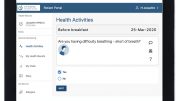The COVID-19 pandemic is challenging health systems around the world. They are responding to an increasing number of ill patients (both those with COVID-19 and patients whose care plans have been disrupted), managing a lack of resources such as personal protection equipment (PPE), administering vaccination programmes at scale, and all whilst maintaining workforce well-being.
With the worldwide deployment of vaccines still underway, health systems will need to continue transforming to adapt to managing COVID-19 alongside other health conditions.
Using cloud technology has already provided benefits to health systems during the pandemic—many of which will persist into the recovery phase. Amazon Web Services (AWS) is helping healthcare systems accelerate the pace of research, support data-driven decision making, and facilitate the delivery of services to citizens and patients, during this crucial time.
Accelerating the pace of research
Since the early stages of the pandemic, academic institutions and other healthcare and research companies have turned to cloud technology to accelerate scientific insights. The cloud supports research at scale and collaboratively between research groups through its reliable and scalable computing power.
For example, Genomics England and their technology platform LifeBit are using cloud technology to deliver Genomic England’s COVID-19 research platform. They provide researchers with access to genomic data from within their highly secure environment, allowing them to collaborate and find new insights quickly.
Health IT company Cerner launched their Learning Health Network, using the analytics capabilities of the cloud, to perform analysis on aggregated and de-identified data from multiple organisations. Through the network, researchers have been able to quickly run algorithms to prove the efficacy of therapies to treat COVID-19.
The Jameel Institute at Imperial College London are using cloud technology to accelerate COVID-19 disease modelling work. They provide public health agencies and governments around the globe with real-time estimates to inform the COVID-19 outbreak response, using a combination of machine learning (ML) and data science methods. Thanks to the cloud, the Imperial College COVID-19 response team can now store more data, share more information and experiment with different methods in ways not previously possible.
And, to facilitate health systems sharing data for research, AWS launched CORD-19: a ML-enabled database of COVID-19 research.
“The trend to share data during the pandemic is leading to positive outcomes, and citizens will benefit from initiatives such as the creation of a European Data Space and further clarity from the European Commission on how the health sector can exchange and use different types of data for healthcare delivery and research whilst fully protecting citizen’s data in compliance with GDPR.”
Enabling data-driven decision making
Access to cloud technology has enabled organisations to innovate and make use of data during the pandemic. Health systems have had greater willingness to use data from multiple sources and have worked with partners to develop dashboards for government leaders.
Governments and public health officials also used more real-time data, from a wider set of sources, and applied artificial intelligence (AI) and ML to infer patterns in virus prevalence and predict where they would need resources in the future.
For example, The World Health Organization (WHO) used AWS to build large-scale data lakes and aggregate epidemiological country data to track the spread of the virus. In the United States, Kinsa, a developer of internet-connected thermometers and a health-tracking app, aggregated real-time fever and symptom information to create visualizations of the spread of the illness.
We have also seen Imperial College London and Pansurg use AWS for their Realtime Data Analysis and Synthesis (REDASA) platform to combat the infodemic of data about COVID-19. The platform uses AWS cloud technology to analyse vast amounts of COVID-19 information in real time. It extracts the most important insights—saving tens of thousands of hours of research and enabling clinicians and policymakers to find the best available evidence for better patient treatments at speed.
Health systems have also seen reductions in treatments for non-COVID-related conditions during 2020, meaning there is likely to be a backlog of patients requiring care in 2021. Prioritisation of this workload will rely on accurate, timely information.
Delivering electronic health and care services to patients and citizens
Healthcare organisations have also tapped into cloud technology to deliver innovative, direct care. The NHS and technology consultancy Slalom, for instance, worked with AWS to set up an automated messaging service to reach the 1.5 million UK citizens identified as most vulnerable to COVID-19. They helped them register to receive social and medical care and essential supplies. This service was set up in 48 hours, thanks to the cloud.
According to a study published by Journal of the American Medical Informatics Association (JAMIA), telehealth services including virtual urgent and non-urgent care visits grew by 683% and 4,345% respectively during the pandemic. Telehealth is the provision of care remotely, using digital technology and telecommunications. Regulatory reform in some countries facilitated this increase.
For example, Brazil and India legalised the use of telemedicine during the pandemic, and Australia made telehealth a permanent part of the way the government will provide the delivery of care going forward. In the US, the federal government enabled Medicare, the federal health insurance programme, to reimburse these services more comprehensively, whilst other states are developing legislation to extend the enhanced access and efficiency of telehealth to meet patient needs beyond the pandemic. In Japan, Canada, and many EU countries, frameworks for telehealth provision were already in place so government policies focused on encouraging more clinicians and patients to use them.
Telehealth providers, like Nye Health, have used the cloud to support this increased demand in telehealth services and scale quickly, in turn, helping patients continue to access clinical advice and care when they needed it. The Nye Health service is fully encrypted, compliant with NHS Digital’s standards and is now servicing thousands of patient consultations a week.
These healthcare innovations have been made possible thanks to the scale and agility that cloud technology offers. Healthcare organisations have been able to continue delivering care thanks to their ability to use the cloud to: scale services to meet patient demand, introduce new services at speed and with flexibility, deliver real-time analytical insights, and accelerate the pace of research. By harnessing the power of the cloud, health systems can continue to support innovation at scale to the benefit of patients and health services.
Article by Nicky Murphy, Head of Healthcare Public Policy, EMEA at Amazon Web Services





